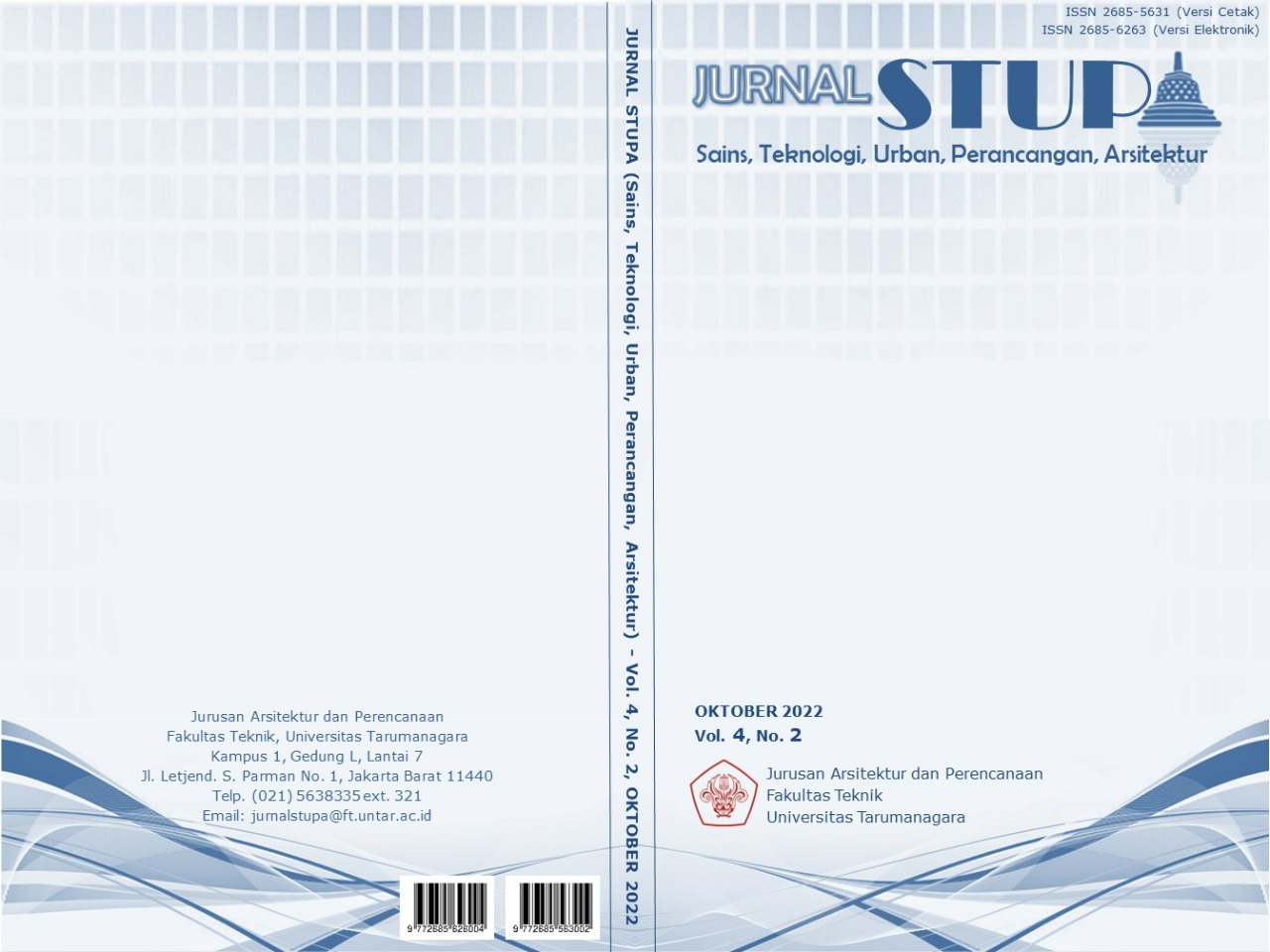RUANG KOMUNAL DAN REKREASI SEBAGAI TEMPAT KETIGA PADA KAWASAN KEBONDALEM
Main Article Content
Abstract
Kebondalem area is one of the old areas which was famous as a center of activity, especially shopping in the city of Purwokerto. Before it was known as a shopping center area, Kebondalem area was famous for its type C bus terminal. The shift in the function of the terminal to shops in 1982, caused this area to become increasingly crowded and dense with shops or stalls to meet the needs of the surrounding communities. However, visitor interest in the area has decreased due to intense economic competition with other areas. The decrease in visitor interest has resulted in this area being left behind with sensitive points of social and physical degradation, such as shops that are starting to close, lack of places to carry out activities, and there are many abandoned facilities and buildings. This degradation event requires an urban acupuncture approach to overcome it. Based on the analysis of the surroundings, this area is surrounded by various kinds of facilities such as educational, office and other commercial facilities. However, with so many educational and office facilities around this area, there is no public space such as third place program as a connection between facilities, such as communal, entertainment or recreational facilities in the center of this area. Therefore, the addition of communal, entertainment or recreation programs as a third place can be a one way to revive this area by applying third place as a concept.
Keywords: Communal Space; Recreation; Third Place; Urban Acupuncture
Abstrak
Kawasan Kebondalem merupakan salah satu kawasan lama yang terkenal sebagai pusat kegiatan khususnya perbelanjaan di kota Purwokerto. Sebelum menjadi kawasan pusat perbelanjaan, kawasan Kebondalem terkenal karena adanya terminal bus tipe C. Adanya pergeseran fungsi terminal menjadi pertokoan pada tahun 1982, menyebabkan kawasan ini menjadi semakin ramai dan padat akan pertokoan atau kios-kios untuk memenuhi kebutuhan masyarakat sekitar. Namun, minat pengunjung pada kawasan tersebut menurun karena persaingan ekonomi yang ketat dengan area lain. Menurunnya minat pengunjung tersebut mengakibatkan kawasan ini tertinggal dengan adanya titik-titik degradasi sosial maupun degradasi fisik, seperti pertokoan-pertokoan mulai tutup, kurangnya tempat untuk melakukan aktivitas, serta banyaknya fasilitas atau bangunan yang terbengkalai. Kejadian degradasi ini memerlukan pendekatan akupunktur perkotaan dalam mengatasinya. Berdasarkan analisis sekitar, kawasan ini dikelilingi oleh berbagai macam sarana fasilitas seperti fasilitas pendidikan, perkantoran dan komersial lainnya. Namun dengan banyaknya fasilitas pendidikan dan perkantoran di sekitar kawasan ini, tidak ada program tempat publik seperti tempat ketiga sebagai penghubung antar fasilitas seperti sarana komunal, hiburan atau rekreasi pada pusat kawasan ini. Maka dari itu, dengan penambahan program ruang berupa komunal, hiburan atau rekreasi sebagai tempat ketiga dapat menjadi salah satu cara untuk menghidupkan kembali kawasan ini dengan menerapkan aspek-aspek konsep tempat ketiga.
Article Details

This work is licensed under a Creative Commons Attribution-NonCommercial-ShareAlike 4.0 International License.
This work is licensed under a Jurnal Sains, Teknologi, Urban, Perancangan, Arsitektur/ STUPA Creative Commons Attribution-NonCommercial-ShareAlike 4.0 International LicenseReferences
Badan Pusat Statistik. 2015. Jumlah Penduduk Menurut Kecamatan dan Agama. Badan Pusat Statistik Kabupaten Banyumas. Banyumas.
Badan Pusat Statistik. 2019. Jumlah Fasilitas Pendidikan Tingkat SD-SMK. Badan Pusat Statistik Kabupaten Banyumas. Banyumas.
Badan Pusat Statistik. 2020. Jumlah Penduduk Menurut Kecamatan dan Jenis Kelamin di Kabupaten Banyumas. Badan Pusat Statistik Kabupaten Banyumas. Banyumas.
Bovy, M. B., & Lawson, F. (1977). Tourism and Recreation Development: A Handbook of Physical Planning. Boston: CBI Publishing Company.
Cahyantoro, E. (2011). Definisi, Tujuan, dan Jenis-Jenis Rekreasi. Retrieved July 5, 2022, from www.mbenxxcaem.blogspot.co.id/2011/09/definisi-tujuan-dan-jenis-jenis.html
Carmona, M., Tiesdell, S., Heath, T., & Oc, T. (2003). Public Places - Urban Spaces, The Dimension of Urban Design. Oxford: Architectural Press.
Carr, S. (1992). Public Space. Cambridge: Cambridge University Press.
Casagrande, M. (2013). Biourban Acupuncture. Treasure Hill of Taipei to Artena. Rome: International Society of Biourbanism.
De Solà-Morales, M. (2008). A Matter of Things. Rotterdam: NAi Publishers.
Djoemena, N. S. (1990). Batik and its Kind. Jakarta: Djambatan.
Haryono, W. (1978). Pariwisata Rekreasi dan Entertainment. Bandung: Ilmu Publisher.
Kaplan, M. (1975). Leisure: Theory and Policy. New York: Wiley Press.
Krippendorff, K. (1994). A Recursive Theory of Communication. In D. Crowley, & D. Mitchell, Communication Theory Today (pp. 78-104). Cambridge: Polity Press.
Kusmayati, H. (2000). Arak-arakan Seni Pertunjukan dalam Upacara Tradisional di Madura. Yogyakarta: Tarawang Press.
Lerner, J. (2014). Urban Acupuncture: Celebrating Pinpricks of Change that Enrich City Life. Washington: Island Press.
Mehta, V. (2007). A Toolkit For Performance Measures Of Public Space. Retrieved February 24, 2022, from https://www.isocarp.net/Data/case_studies/983.pdf
Nufus, Asri H. (2021). Batik Banyumas: Ekspresi Wastra Masyarakat Banyumas. Retrieved July 3, 2022, from https://skalacerita.com/batik-banyumas/
Oldenburg, R. (1989). The Great Good Place. United States: Da Capo Press.
Peraturan Daerah Kabupaten Banyumas Nomor 10 Tahun 2011. Rencana Tata Ruang Wilayah Kabupaten Banyumas Tahun 2011 – 2031. Banyumas: Bupati Banyumas.
Shidan, C., & Qian, S. (2011). “Urban Acupuncture” Strategy in the Urban Renewal. Lushan: International Conference on Electric Technology and Civil Engineering (ICETCE).
Siadari, C. (2016). Pengertian Rekreasi dan Tujuan Rekreasi. Retrieved July 3, 2022, from https://www.kumpulanpengertian.com/2016/02/pengertian-rekreasi-dan-tujuan-rekreasi.html
Stupar, A., & Savcic, V. (2009). The New Urban Acupuncture: Intermodal Nodes between Theory and Practice. Schwechat: COPR - Competence Center of Urban and Regional Planning.
Tokoneinyong. (2016). Kawasan Kebondalem Purwokerto Akan Dihidupkan Lagi. Retrieved February 24, 2022, from https://www.kaskus.co.id/thread/57067430925233085b8b4569/kawasan-kebondalem-purwokerto-akan-dihidupkan-lagi/
Tylor, E. B. (1871). Primitive Culture. London: Cambridge University Press.



